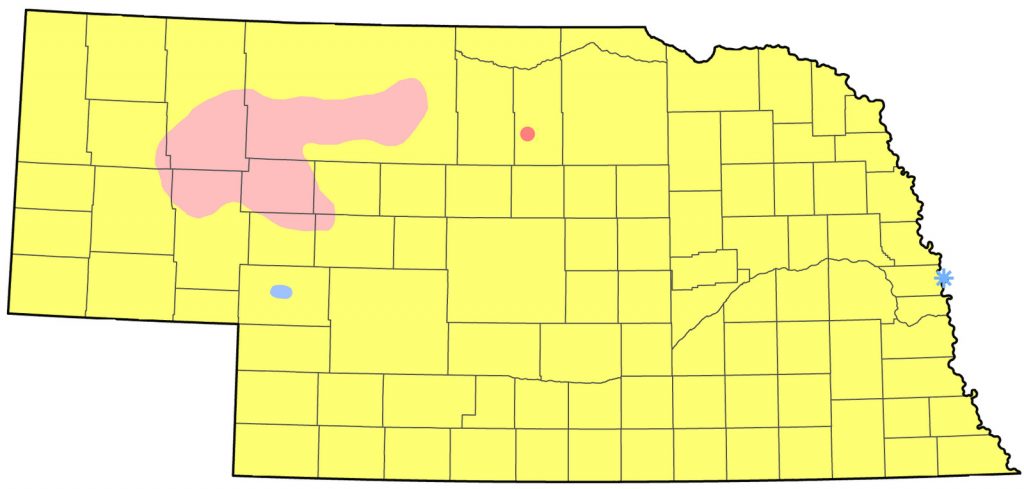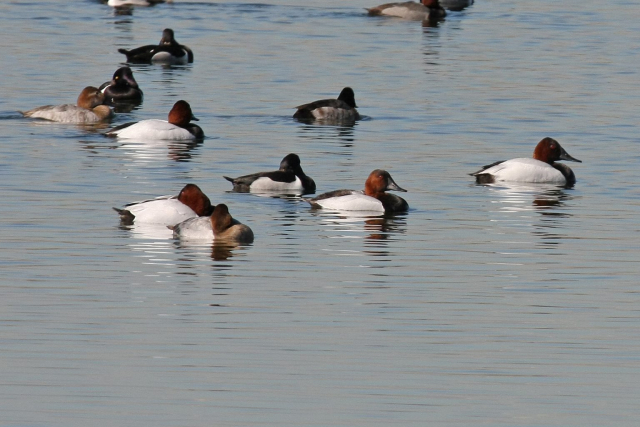Aythya valisineria
Status: Common, locally abundant, regular spring and fall migrant statewide. Rare, locally uncommon, regular breeder western Sandhills. Rare casual summer visitor statewide. Uncommon regular winter visitor North Platte and Platte river valleys south, rare casual elsewhere.

Documentation: Specimen: UNSM ZM12458, 3 Apr 1932 Red Willow Co.
Taxonomy: No subspecies are recognized (AviList 2025).
For Nebraska records of hybrids with Redhead, see Canvasback x Redhead.
Spring: Jan 25, 26, 27 <<<>>> Jun 1, 1, 2
Migrants may arrive as water opens; 11 were at Harlan County Reservoir, Harlan Co 25 Jan 2002, and 40 near Roscoe, Keith Co 28 Jan 2016. The spring movement typically peaks in late Mar, with migrants continuing to pass through into early May.
Late dates above are from locations where summering birds were absent; there are later dates that are likely non-breeding immatures: 4 Jun 2021 Lancaster Co, and 8 Jun 2001 Chase Co.
Rosche (1982) considered this species to be an abundant spring migrant in the Panhandle, and peak numbers at Crescent Lake NWR, Garden Co support that assessment; 1900 were there 15 Apr 1980, exceeded only by 2600 Gadwall and 2775 Lesser Scaup (Fred Zeillemaker, personal communication).
- High counts: 5000 at Lake McConaughy, Keith Co on 21 Mar 1993 (Rosche 1994), 3000 at Lake McConaughy 21 Mar 2023, 1900 at Crescent Lake NWR on 15 Apr 1980, and 1514 in the eastern Rainwater Basin 24 Mar 2001.
Summer: Small numbers of Canvasbacks breed locally in the western Sandhills. In the 1980s, 10-20 breeding pairs were reported at Crescent Lake NWR (Fred Zeillemaker, personal communication), and, more recently, 25 individuals were counted there 12 Jul 1995, and 18 on 7 Aug 2012. A count of 29 was made at Swede Lake, Grant Co 8 Aug 2012, and a female on a nest with one egg was at Avocet WMA, Grant Co 21 May 2018. Breeding apparently still occurs in this area but numbers may have declined. A brood seen in Sheridan Co 21 May 2015 was the first reported since 1958, when numbers were “decreasing steadily” (Harvey Miller, NGPC, letter to William Lemburg 15 Dec 1958). Mollhoff (2016) showed an extralimital breeding record in Rock Co; singles were in Rock Co 13 Jun 2019, 30 Jun 2022, 15 Aug 2023, and 8 Jun 2024, the latter at Twin Lakes Rock County WMA. Four were south of Bassett, Rock Co 8 Jun 2025. A brood was photographed near Merritt Reservoir, Cherry Co 30 Jul 2019 (Gregory Wright, personal communication). Johnsgard (1997) described it as a “local and rare summer resident in the Sandhills (Valentine NWR)”; there are no recent breeding records in Cherry Co (Mollhoff 2016) although five were there 16 Jun 2019.
Most reports away from the breeding range are in counties adjacent to the breeding range: in the northwest, Scotts Bluff, Box Butte, and Dawes, and to the south McPherson, Lincoln, Custer, and Keith.
In 2019 there was a remarkable influx to areas not known as breeding locations of late spring and summer Canvasbacks, possibly one-year-old immature non-breeders with delayed maturity resulting from late broods in 2018: 23 May Douglas Co, 25 May Clay Co, up to four 6 May-13 Jun and four on 16 Sep Rock Co, 30 May York Co, 4 Jun Buffalo Co, five pairs in Clay Co 19 Jun with singles there 21 Jun and 11 Jul, up to five at a Butler Co wetland 23 May-19 Jun, four males and a female in Fillmore Co 13 Jun, three near Shickley, Clay Co 15 Jun, 28 Jun Brown Co, and 2 Aug Dawson Co.
Elsewhere there are few recent reports, most from the Rainwater Basin, where a few occasionally linger into Jul: two on 9 Jun 2015 Clay Co, 14 Jun 1929 Harvard WPA, Clay Co (Jorgensen 2012), 21-22 Jun 2014 York Co, 30 Jun 1993 Hamilton Co, and 6 Jul 1997 Funk WPA, Phelps Co. A male was in Richardson Co 1 Jul 2013, and there is a report from Lancaster Co 16 Jul 1971 and four older reports in Brown Co: 20 May-Aug 1971, 19 Jun 1967, 30 Jun 1964, and 4 Jul-2 Sep 1973.
- Breeding phenology:
- Eggs: 14 May- 11 Jun (Mollhoff 2022).
Dependent fledglings: 21 May- 30 Jul.
Fall: Sep 21, 21, 23 <<<>>> Jan 14, 15, 17
An early date was 15 Sep 2023 Lake Alice, Scotts Bluff Co.
The fall migration begins in early Oct and continues until mid-Dec or later if open water is available. Peak numbers occur in late Oct.
The status of the few late Jul through mid-Sep reports from areas where regular breeding does not occur is uncertain, but likely refer to immature non-breeders; molt migration in this species is generally northward from breeding areas (Baldassarre 2014). Such late summer-early fall records include: 8 Jul-17 Aug 1988 Lincoln Co, 16 Jul 1971 Lancaster Co, 22-23 Jul 2024 subadult male Alma WTP, Harlan Co, 2-3 on 4 Aug 2008 North Platte WTP, Lincoln Co, 9 Aug 2013 Lancaster Co, 10 Aug 1975 Adams Co, 10 Aug 1999 Cuming Co, 21 Aug 1973 Lancaster Co, 22 Aug 2017 Imperial SL, Chase Co, two on 24 Aug 2013 Lake Ogallala, Keith Co, 29 Aug 1997 Johnson WPA, Phelps Co, two on 2 Sep 2017 Lake Ogallala, 4 Sep 2023 male Furnas Co, a male at Capitol Beach Lake 7-16 Sep 2017 Lancaster Co, 8 Sep 2000 Lake Ogallala, and 11 Sep 1982 Douglas-Sarpy Cos.
- High counts: 3000 at Crescent Lake NWR, Garden Co on 5 Nov 1994, 1388 at Lake McConaughy 31 Oct 2006, and 1200 at Crescent Lake NWR 23 Oct 1995.
Winter: Small numbers overwinter at favored locations from the North Platte and Platte river valleys southward given suitable water conditions, notably at the Lake McConaughy area; at Lake Ogallala, as many as 87 wintered 1999-2000, and lesser numbers occur most winters. The 316 at Lake Ogallala 30-31 Dec 2011 was a large number for the late date. Carter Lake, Douglas Co hosted wintering birds 2011-2012 through 2016-2017; best counts were 40 on 12 Jan 2012, and 38 on 13 Jan 2013.
Elsewhere, there are these reports of wintering (mid-Jan) birds: two wintered at Skyview Lake, Madison Co 2019-2020, and one was at Ta-Ha-Zouka Park, Madison Co 2-20 Jan 2022.
- High counts: 250 at Lake Ogallala, Keith Co 18 Jan 2025, 87 at Lake McConaughy winter 1999-2000, 83 at Sutherland Reservoir, Lincoln Co 19 Jan 2024, and 60 at Lake McConaughy 11 Jan 1987 (Rosche 1994).
Images
Abbreviations
NGPC: Nebraska Game and Parks Commission
NWR: National Wildlife Refuge
SL: Sewage Lagoons
UNSM: University of Nebraska State Museum
WMA: Waterfowl Management Area (State)
WPA: Waterfowl Production Area (Federal)
WTP: Water Treatment Plant
Literature Cited
AviList Core Team, 2025. AviList: The Global Avian Checklist, v2025. https://doi.org/10.2173/avilist.v2025.
Baldassarre, G. 2014. Ducks, geese, and swans of North America. Johns Hopkins University Press, Baltimore, Maryland, USA.
Johnsgard, P.A. 1997. The birds of Nebraska and adjacent plains states. Occasional Papers No. 6, Nebraska Ornithologists’ Union. Lincoln, Nebraska, USA.
Jorgensen, J.G. 2012. Birds of the Rainwater Basin, Nebraska. Nebraska Game and Parks Commission, Lincoln, Nebraska, USA.
Mollhoff, W.J. 2016. The Second Nebraska Breeding Bird Atlas. Bull. Univ. Nebraska State Museum Vol 29. University of Nebraska State Museum, Lincoln, Nebraska, USA.
Mollhoff, W.J. 2022. Nest records of Nebraska birds. Nebraska Ornithologists’ Union Occasional Paper Number 9.
Rosche, R.C. 1982. Birds of northwestern Nebraska and southwestern South Dakota, an annotated checklist. Cottonwood Press, Crawford, Nebraska, USA.
Rosche, R.C. 1994. Birds of the Lake McConaughy area and the North Platte River valley, Nebraska. Published by the author, Chadron, Nebraska, USA.
Recommended Citation
Silcock, W.R., and J.G. Jorgensen. 2025. Canvasback (Aythya valisineria). In Birds of Nebraska — Online. www.BirdsofNebraska.org
Birds of Nebraska – Online
Updated 19 Aug 2025
![[envira-gallery id="14246"] [envira-gallery id="14246"]](https://birds.outdoornebraska.gov/wp-content/uploads/2018/03/Canvasback-640x480.jpg)

